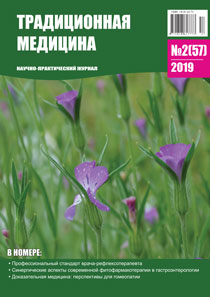Pathogens and state of the main organ systems according to vegetative resonance test data in patients with acne
Keywords:
Acne, VRT, endocrine system, colitis, Candida albicans, Staphylococcus epidermalis, Propionebacterium acne, Klebsiella pneumonia, dust mites, Demodex mitesAbstract
We observed 30 patients with complaints of acne during 2016–2017, as well as 30 patients of the control group of the corresponding age and sex without acne. All patients underwent a comprehensive examination by the method of Vegetative Resonance Test. All patients were exanimated with the similar spectrum of the tested markers. Almost a quarter of patients with acne showed signs of inflammation of the large intestine which was absent in the control group (p = 0.011, Fisher's exact test). Pathological changes of the endocrine system were more than twice as frequent in acne patients as in the control group (63.3 % vs 30 %, respectively, p = 0.019, Fisher's exact test). We revealed significant differences between the patients with acne and control group in the spectrum and severity of bacterial load, as well as in such pathogens as Candida fungi and mites. Candida albicans and Candida parapsilosis were determined three times more often in acne patients (80 % vs 27 %, p = 0.0001 and 73 % vs 23 %, p = 0.0002, respectively, Fisher's exact test) and these patients also had a significantly higher level of fungal load (p = 0.0001, Pearson criterion ?2).
Staphylococcus epidermalis (70 % vs 3 %, p < 0.0001, Fisher's exact test), Propionebacterium acne (77 % vs 0 %, p < 0.0001, Fisher's exact test) and Klebsiella pneumonia (57 % vs 23 %, p = 0.017, Fisher's exact test) were more frequently determined in patients with acne too. Approximately a half of acne patients had dust mites and 30 % of acne patients had Demodex mites burden revealed, while these pathogens were not detected in the control group (53 % vs 0 %, p < 0.0001 and 30 % vs 0 %, p = 0.0019, respectively, Fisher's exact test).
References
Полонская Н. А. Комплексное лечение угревой болезни среднетяжелого и тяжелого течения комбинированным химическим пилингом в сочетании с низкими дозами изотретиноина: Автореф. дис. канд. мед. наук. – Москва, 2005. – 35 с.
Клименкова Н.В., Шиманская И.Г. Современные подходы к лечению акне и постакне // Международные обзоры: клиническая практика и здоровье. – 2017. – №3. – С.59–68.
Кривоногова П.Л. Биткина О.А., Мартусевич А.К. Патогенетическое обоснование методов лечения акне: обзор современных представлений и собственные данные // Медицинский альманах. – 2017. – №2. – Т.47. – С.122–126.
Анисимова М.Ю. Акне (acne vulgaris) с позиции доказательной медицины // Вестник репродуктивного здоровья. – 2010. – №3–4. – С.14–23.
Готовский Ю.В. [и др.] Электропунктурная диагностика и терапия с применением вегетативного резонансного теста «ИМЕДИС-ТЕСТ». Методические рекомендации. 3-е изд., перераб. и доп. – М.: ИМЕДИС, 2000. – 151 с.
Аванесова Е.Г. [и др.] Применение вегетативного резонансного теста «ИМЕДИС-ТЕСТ» в клинической практике. 2-е изд. – М.: ИМЕДИС, 2007. – 164 с.
Downloads
Published
How to Cite
Issue
Section
License
Reproduction of any materials without the written permission of the publisher is prohibited.
The responsibility for the accuracy of the information contained in articles and advertisements are the authors and advertisers.


